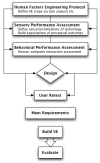User-centered virtual environment design for virtual rehabilitation
- PMID: 20170519
- PMCID: PMC2837672
- DOI: 10.1186/1743-0003-7-11
User-centered virtual environment design for virtual rehabilitation
Abstract
Background: As physical and cognitive rehabilitation protocols utilizing virtual environments transition from single applications to comprehensive rehabilitation programs there is a need for a new design cycle methodology. Current human-computer interaction designs focus on usability without benchmarking technology within a user-in-the-loop design cycle. The field of virtual rehabilitation is unique in that determining the efficacy of this genre of computer-aided therapies requires prior knowledge of technology issues that may confound patient outcome measures. Benchmarking the technology (e.g., displays or data gloves) using healthy controls may provide a means of characterizing the "normal" performance range of the virtual rehabilitation system. This standard not only allows therapists to select appropriate technology for use with their patient populations, it also allows them to account for technology limitations when assessing treatment efficacy.
Methods: An overview of the proposed user-centered design cycle is given. Comparisons of two optical see-through head-worn displays provide an example of benchmarking techniques. Benchmarks were obtained using a novel vision test capable of measuring a user's stereoacuity while wearing different types of head-worn displays. Results from healthy participants who performed both virtual and real-world versions of the stereoacuity test are discussed with respect to virtual rehabilitation design.
Results: The user-centered design cycle argues for benchmarking to precede virtual environment construction, especially for therapeutic applications. Results from real-world testing illustrate the general limitations in stereoacuity attained when viewing content using a head-worn display. Further, the stereoacuity vision benchmark test highlights differences in user performance when utilizing a similar style of head-worn display. These results support the need for including benchmarks as a means of better understanding user outcomes, especially for patient populations.
Conclusions: The stereoacuity testing confirms that without benchmarking in the design cycle poor user performance could be misconstrued as resulting from the participant's injury state. Thus, a user-centered design cycle that includes benchmarking for the different sensory modalities is recommended for accurate interpretation of the efficacy of the virtual environment based rehabilitation programs.
Figures








References
-
- Rizzo AA, Buckwalter JG. In: Virtual Reality in Neuro-Physiology. Riva G, editor. Amsterdam, Netherlands, IOS Press; 1997. Virtual reality and cognitive assessment and rehabilitation: the state of the art; pp. 123–146. - PubMed
-
- Rizzo AA, Kim GJ. A SWOT Analysis of the field of virtual rehabilitation and therapy. Presence. 2005;14(2):119–146. doi: 10.1162/1054746053967094. - DOI
-
- Schultheis MT, Rizzo AA. The application of virtual reality technology for rehabilitation. Rehab Psychol. 2001;46(3):296–311. doi: 10.1037/0090-5550.46.3.296. - DOI
Publication types
MeSH terms
LinkOut - more resources
Full Text Sources
Medical
Research Materials

